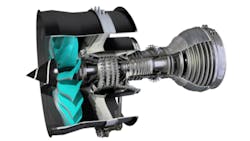Rolls-Royce Plc revealed two new jet engine designs it indicated would be in service with aircraft OEMs in the next decade, emphasizing materials and technologies it said would augment performance, improve fuel economy, and reduce CO2 emissions. London-based Rolls is the world’s second-largest supplier of jet engines to manufacturers like Airbus, Boeing, and others.
The group’s current standard engine for commercial jets is the Trent series high-bypass turbofan engines, in particular the Trent XWB chosen for the new Airbus A350, which the developer called “the world's most efficient engine flying today.” Rolls-Royce has about 2,500 of its Trent engines in service and a similar number on order.
The first new design, called Advance, is planned for introduction by 2020. Rolls said Advance would be at least 20% more fuel-efficient, with comparable reduction in CO2 emissions, than its first generation of Trent engines.
The second new engine, called UltraFan™, will introduce geared turbofan technology to the Rolls-Royce portfolio. Geared designs are more typically associated with rivals Pratt & Whitney and Honeywell. Rolls stated the UltraFan would come to market in 2025, and will provide at least 25% more fuel-efficiency and similarly lower emissions levels.
"These new designs are the result of implementing our ongoing technology programs,” according to Colin Smith, director of Engineering and Technology. “They are designed to deliver what our airframe and airline customers tell us they need: even better fuel efficiency, reliability and environmental performance."
Both engine designs are the result of an ongoing research and development investment Rolls-Royce at of approximately £1 billion/year, which Rolls-Royce makes across its aerospace and non-aerospace businesses.
Both new designs incorporate designs and technology that are “at an advanced stage of development,” including a new engine core architecture; carbon/titanium (CTi) fan blades and a composite casing that reduce weight by up to 1,500 lb./aircraft; and advanced ceramic matrix composites that deliver heat resistance for effectiveness at higher operating temperatures.
Rolls-Royce also reported it has developed and tested technologies to support the Open Rotor engine concept, and is positioned to develop these further upon indication of suitable market demand for such products.
"As innovators, we can never stand still, even when we have the leadership position,” stated Eric Schulz, President - Civil Large Engines for Rolls-Royce. ”Our horizons extend into the coming decades and we have amassed a range of new technologies to meet the needs of our customers. I am confident that our engine design strategy will ensure we power the future of global aviation."
About the Author
Robert Brooks
Content Director
Robert Brooks has been a business-to-business reporter, writer, editor, and columnist for more than 20 years, specializing in the primary metal and basic manufacturing industries.
